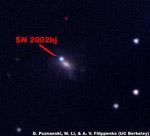
(Written by Christine Pulliam, Smithsonian Astrophysical Observatory, for Science at the Smithsonian, a website featuring highlights of scientific research at the Smithsonian Institution. )
In our universe, few events rival the massive power and destruction of an exploding star, or supernova. In a matter of seconds, an entire star shreds itself into pieces that blast outward at speeds of 20 million miles per hour. A supernova glows so brightly it can outshine an entire galaxy of stars, emitting as much energy as our Sun will in its entire 10-billion-year lifetime.
If a supernova were to happen within 25 light-years (150 trillion miles) of Earth, it would spell disaster for our world. Fortunately, no star that close is expected to explode.
For decades, astronomers divided supernovas into two groups: one from young stars that explode and one from old stars that explode. They now have evidence for a new, third type of supernova explosion whose source is still a mystery.
“We can’t explain what’s causing them yet. That’s what makes them so interesting,” says Dr. Hagai Perets of the Harvard-Smithsonian Center for Astrophysics.